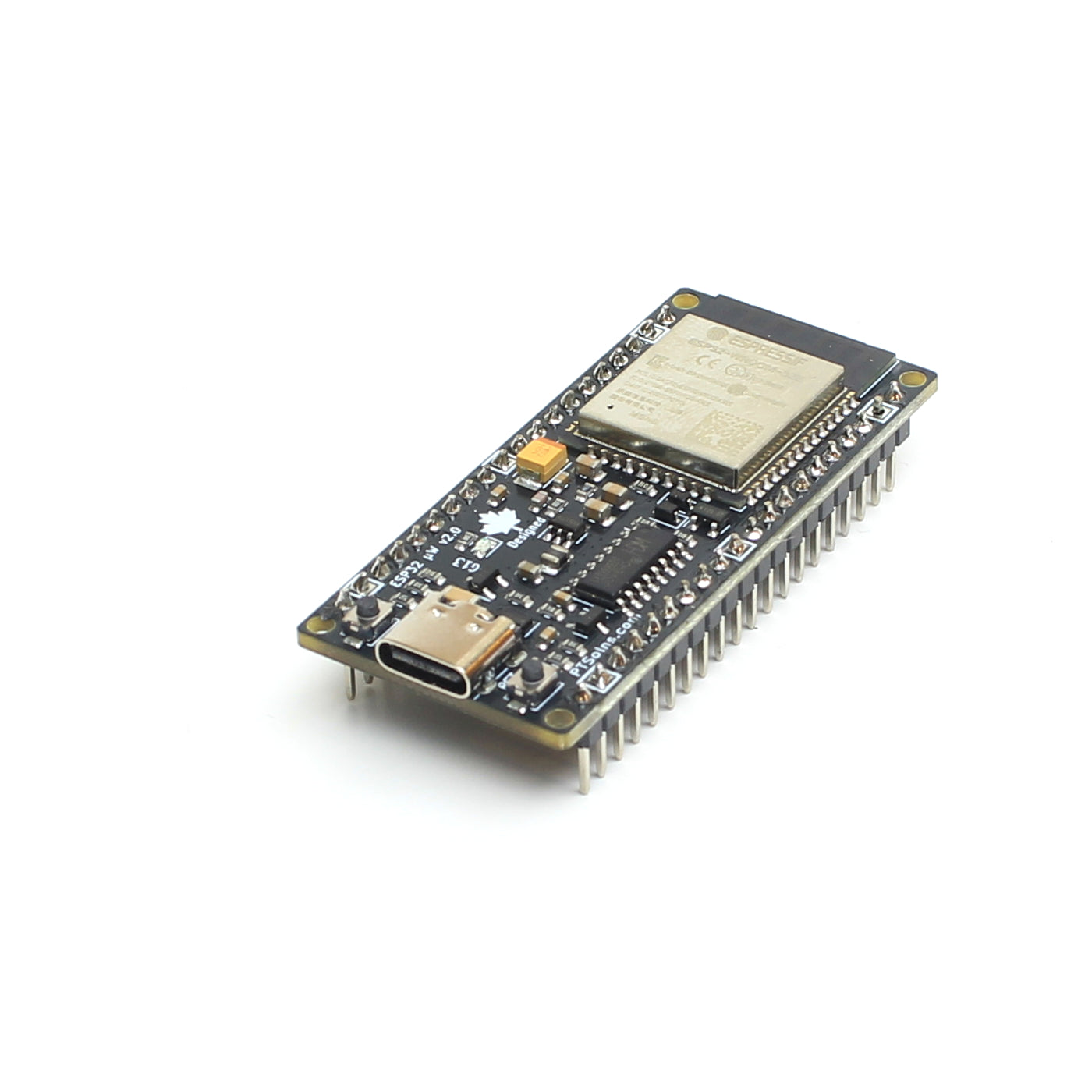
In this blog post we want to test and compare the 3.3V pin of three popular Nano microcontroller development boards:
All of these Nano development boards share the same pinout, but each one uses a different regulator circuit and PCB layout for the 3.3V rail. As a result, they vary significantly in current handling, voltage stability, and thermal performance. To evaluate and compare their performance, we applied known loads to the 3.3V pin and measured both voltage quality and temperature rise.
The comparison is divided into five test categories. The top-performing board in each category earns one point. At the end, the board with the highest total score is declared the overall winner. The test categories are:
- Category 1: Current rating as per datasheet
- Category 2: Temperature rise under a small load
- Category 3: Voltage quality of the 3.3V pin under a small load
- Category 4: Temperature rise under a large load
- Category 5: Voltage quality of the 3.3V pin under a large load
Test Setup
The three Nano microcontroller development boards tested in this blog post are:

We used our adjustable resistive load from a previous tutorial to precisely control the current drawn from the 3.3V pin. This load can be tuned from 0 mA to 1000 mA, but for this test, we selected two specific current levels:
- Small load: 50 mA
- Large load: 100 mA
These levels were chosen based on the rated current handling of the three Nano development boards, which will be discussed in more detail in Category 1.
To ensure consistent current draw across all tests, a multimeter was placed in series with the 3.3V output. Because each board regulates its 3.3V output differently, the resistive load was fine-tuned in each case to maintain the exact target current (50 mA or 100 mA), in accordance with Ohm’s Law.
For measuring voltage quality, an oscilloscope was connected to the 3.3V pin to capture both the DC voltage level and the peak-to-peak ripple. This provides insight into how clean and stable each board's 3.3V output is under load.
To assess thermal performance, we used a thermal camera and imaging software to capture the hottest component on the board, which in our case is going to be the 3.3V regulator as we are stressing this component, and the ambient temperature. The temperature rise is calculated as the difference between the two.
Test & Results
Here we will go through each of the five categories and at the end we will tabulate all the findings.
Category 1: Current rating as per datasheet
PTSolns Nano Flip
The current rating of the PTSolns Nano Flip is listed as 160mA as per the datasheet (page 14). The Nano Flip has a dedicated linear voltage regulator to supply the 3.3V pin, which is the XC6206P332. This component has a rated maximum current draw of 200mA. However, the onboard the Nano Flip, this rating has been down rated to 160mA to ensure stable operation.
Arduino Nano
The current rating of the Arduino Nano is listed as 50mA as per the datasheet (page 8). The Arduino Nano does not have a dedicated linear voltage regulator to supply the 3.3V pin. Rather, the board uses the FT232RL, which is primarily used as a USB-to-UART communication IC between the USB port and the microcontroller (ATmega328P). The Arduino Nano makes dual use of this IC and also uses it to supply the 3.3V pin as the FT232RL has a built-in regulator. Since it is not it's primary function, the rating is rather low at only 50mA.
Generic Nano
The generic Nano does not have any datasheet. However, we were able to identify the linear voltage regulator used onboard to likely be the MIC5365-3.3YC5-TR. This component has a rating of 150mA. As with the Nano Flip where the actual regulator was down rated from 200mA to 160mA, it is assumed that the designers of this generic Nano also had intended somewhat of a down rating from 150mA to ... well, what? There is no datasheet we could find. Maybe there is no down rating. So to be fair, we will assume the rating on the 3.3V pin on the board is the full 150mA. This is generous....
Winner of Category 1
Point goes to PTSolns Nano Flip with a listed rating of 160mA.
Note 1: Due to the low rating on the Arduino Nano, this board cannot participate in the tests of Category 3 and 4.
Note 2: The PTSolns Nano Flip is the only board that has the regulator on the top side of the board, while the other two have the respective regulators on the bottom.
Category 2: Temperature rise under a small load
PTSolns Nano Flip
The temperature rise of the PTSolns Nano Flip under a 50mA load on the 3.3V pin is 13.6 degrees C.

Arduino Nano
The temperature rise of the Arduino Nano under a 50mA load on the 3.3V pin is 10.7 degrees C.

Generic Nano
The temperature rise of the Generic Nano under a 50mA load on the 3.3V pin is 22.7 degrees C.

Winner of Category 2
Point goes to Arduino Nano with a lowest temperature rise of 10.7 degree C under a 50mA load on the 3.3V pin.
Note 1: The IC used on the Arduino Nano is physically much larger compared to the respective other regulators. This allows for more temperature dispersion and a lower peak temperature. The PTSolns Nano Flip and the Generic Nano have physically much more similar footprints and therefore their temperature comparison is better matched.
Category 3: Voltage quality of the 3.3V pin under a small load
PTSolns Nano Flip
Under a 50mA load on the 3.3V pin, the PTSolns Nano Flip was able to maintain a voltage of 3.29±0.17V.
Arduino Nano
Under a 50mA load on the 3.3V pin, the Arduino Nano was able to maintain a voltage of 3.18±0.62V.
Generic Nano
Under a 50mA load on the 3.3V pin, the Generic Nano was able to maintain a voltage of 3.32±0.18V.
Winner of Category 3
Point goes to PTSolns Nano Flip with the best voltage quality on the 3.3V pin while under a 50mA load.
Category 4: Temperature rise under a large load
PTSolns Nano Flip
The temperature rise of the PTSolns Nano Flip under a 100mA load on the 3.3V pin is 25.2 degrees C.

Arduino Nano
The Arduino Nano does not qualify for this test due to the low current rating on the 3.3V pin.
Generic Nano
The temperature rise of the Generic Nano under a 100mA load on the 3.3V pin is 39.7 degrees C.

Winner of Category 4
Point goes to PTSolns Nano Flip with a lowest temperature rise of 25.2 degree C under a 100mA load on the 3.3V pin.
Category 5: Voltage quality of the 3.3V pin under a large load
PTSolns Nano Flip
Under a 100mA load on the 3.3V pin, the PTSolns Nano Flip was able to maintain a voltage of 3.27±0.17V.
Arduino Nano
The Arduino Nano does not qualify for this test due to the low current rating on the 3.3V pin.
Generic Nano
Under a 100mA load on the 3.3V pin, the Generic Nano was able to maintain a voltage of 3.33±0.19V.
Winner of Category 5
Point goes to PTSolns Nano Flip with the best voltage quality on the 3.3V pin while under a 100mA load.
Tabulated Results
The table below outlines all the test results.
| Quantity | PTSolns Nano Flip | Arduino Nano | Generic Nano |
| I_3.3V Rating | 160mA | 50mA | 150mA |
| IC | XC6206P332 | FT232RL | 662K |
| Temp. Rise at 50mA load on 3.3V [deg C] | 13.6 | 10.7 | 22.7 |
| V_3.3V at 50mA load on 3.3V [V] | 3.29±0.17V | 3.18V+-.62 | 3.32±0.18V |
| Temp. Rise at 100mA load on 3.3V [deg C] | 25.2 | N/A | 39.7 |
| V_3.3V at 100mA load on 3.3V [V] | 3.27±0.17V | N/A | 3.33±0.19V |
The PTSolns Nano Flip earned 4 points and is declared the winner.
The Arduino Nano earned 1 point, while the Generic Nano earned no points.
And the Winner Is… the PTSolns Nano Flip
The PTSolns Nano Flip outperformed both competitors across key categories. It delivered the highest current rating and the best voltage quality on the 3.3V pin under both 50 mA and 100 mA load conditions.
While the Arduino Nano board showed the lowest temperature rise at 50 mA, it suffered from poor voltage regulation, with a peak-to-peak ripple of 0.62 V and an average DC voltage of 3.18 V—a full 120 mV below the expected 3.3 V. This is likely due to the fact that it lacks a dedicated 3.3 V linear regulator, instead relying on a secondary function of another onboard IC. While this design limits thermal output due to the larger IC footprint, it also severely restricts current handling and voltage quality.
At 100 mA, the Nano Flip also delivered the best thermal performance, with a temperature rise of just 25.2 °C, compared to 39.7 °C on the Generic Nano.
In summary, the Nano Flip leads in current capability, voltage stability, and maintains a safe thermal profile, making it the clear winner.

